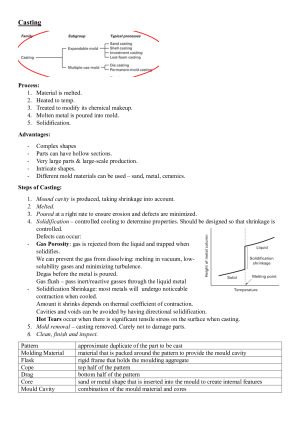Manufacturing Notes
Subject notes for UWA MECH2003
Description
Chapter 1: Casting – forming complex metal parts by pouring molten metal into molds, controlling flow, solidification, and defects. Chapter 2: Metal Working – shaping solid metals through deformation processes like rolling, forging, extrusion, and sheet forming. Chapter 3: Machining – removing material using cutting tools to achieve precision dimensions, surface finishes, and tolerances. Chapter 4: Joining – permanently or semi-permanently connecting materials via welding, brazing, soldering, adhesives, or mechanical fasteners. Chapter 5: Measurement, Inspection & Testing – ensuring part quality and dimensional accuracy using gauges, instruments, and destructive or non-destructive testing. Chapter 6: Engineering Drawings – standardized technical drawings that communicate dimensions, tolerances, materials, and manufacturing requirements. Chapter 7: Concrete & Cement – understanding mix composition, curing, reinforcement, and testing to achieve strong, durable structures. Chapter 8: Polymers & Composites – producing lightweight plastic and composite products using moulding, extrusion, and layering to enhance strength and performance.
UWA
Semester 1, 2025
21 pages
4,857 words
$29.00
Campus
UWA, Crawley
Member since
May 2022
